2017 Hyundai Elantra clock
[x] Cancel search: clockPage 15 of 571
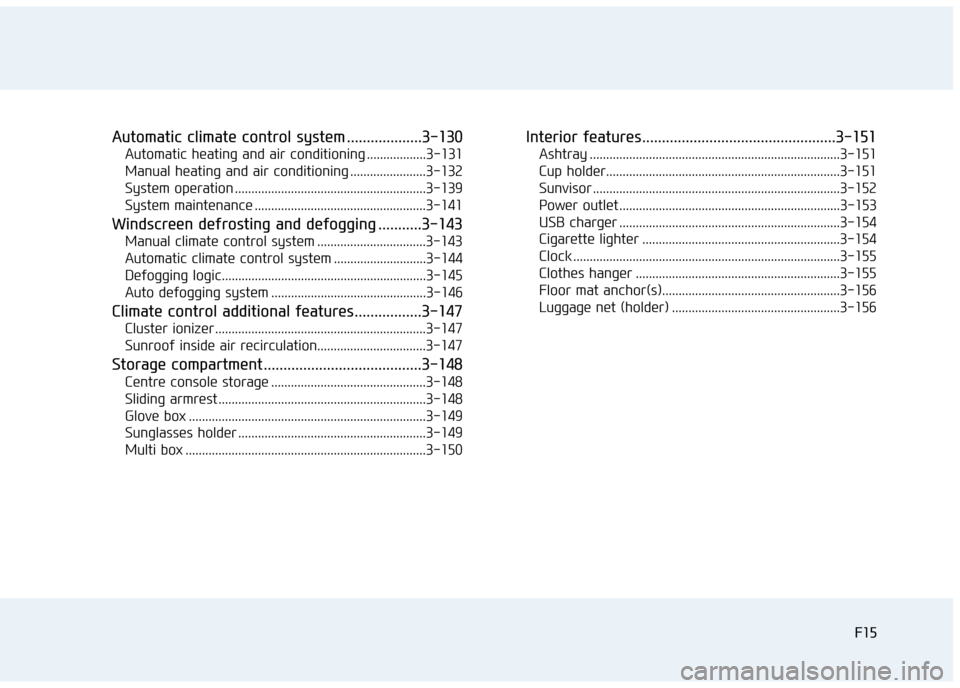
F15F15
Automatic climate control system ...................3-130
Automatic heating and air conditioning ..................3-131
Manual heating and air conditioning .......................3-132
System operation ..........................................................3-139
System maintenance ....................................................3-141
Windscreen defrosting and defogging ...........3-143
Manual climate control system .................................3-143
Automatic climate control system ............................3-144
Defogging logic..............................................................3-145
Auto defogging system ...............................................3-146
Climate control additional features.................3-147
Cluster ionizer ................................................................3-147
Sunroof inside air recirculation.................................3-147
Storage compartment ........................................3-148
Centre console storage ...............................................3-148
Sliding armrest ...............................................................3-148
Glove box ........................................................................3-149
Sunglasses holder .........................................................3-149
Multi box .........................................................................3-150
Interior features.................................................3-151
Ashtray ............................................................................3-151
Cup holder.......................................................................3-151
Sunvisor ...........................................................................3-152
Power outlet ...................................................................3-153
USB charger ...................................................................3-154
Cigarette lighter ............................................................3-154
Clock .................................................................................3-155
Clothes hanger ..............................................................3-155
Floor mat anchor(s)......................................................3-156
Luggage net (holder) ...................................................3-156
Page 32 of 571
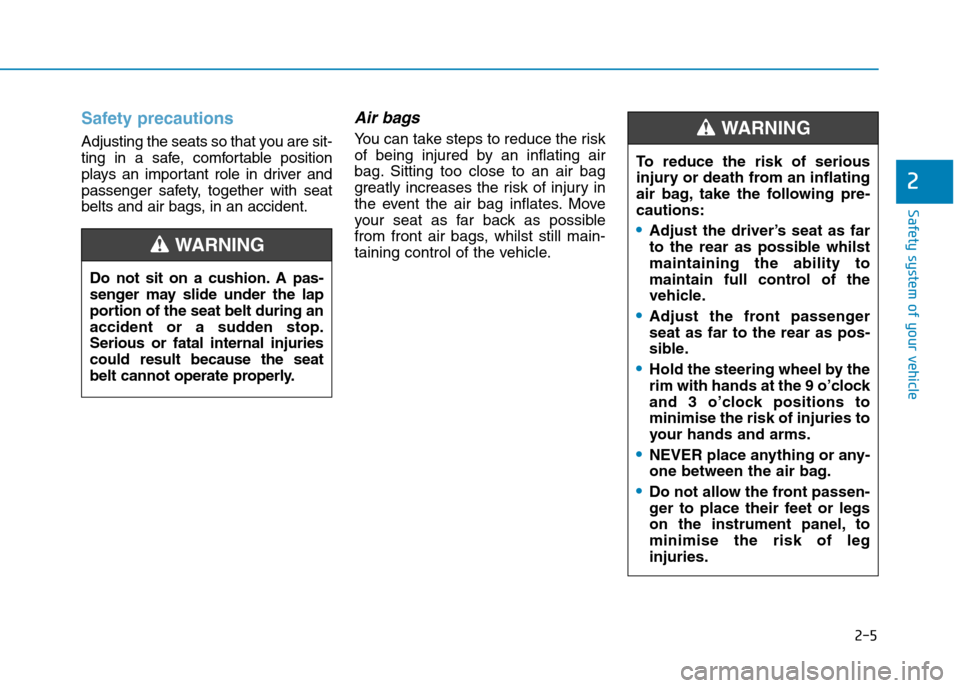
2-5
Safety system of your vehicle
2
Safety precautions
Adjusting the seats so that you are sit-
ting in a safe, comfortable position
plays an important role in driver and
passenger safety, together with seat
belts and air bags, in an accident.
Air bags
Yo u c a n t a k e s t e p s t o r e d u c e t h e r i s k
of being injured by an inflating air
bag. Sitting too close to an air bag
greatly increases the risk of injury in
the event the air bag inflates. Move
your seat as far back as possible
from front air bags, whilst still main-
taining control of the vehicle.
Do not sit on a cushion. A pas-
senger may slide under the lap
portion of the seat belt during an
accident or a sudden stop.
Serious or fatal internal injuries
could result because the seat
belt cannot operate properly.
WA R N I N G
To r e d u c e t h e r i s k o f s e r i o u s
injury or death from an inflating
air bag, take the following pre-
cautions:
•Adjust the driver’s seat as far
to the rear as possible whilst
maintaining the ability to
maintain full control of the
vehicle.
•Adjust the front passenger
seat as far to the rear as pos-
sible.
•Hold the steering wheel by the
rim with hands at the 9 o’clock
and 3 o’clock positions to
minimise the risk of injuries to
your hands and arms.
•NEVER place anything or any-
one between the air bag.
•Do not allow the front passen-
ger to place their feet or legs
on the instrument panel, to
minimise the risk of leg
injuries.
WA R N I N G
Page 77 of 571
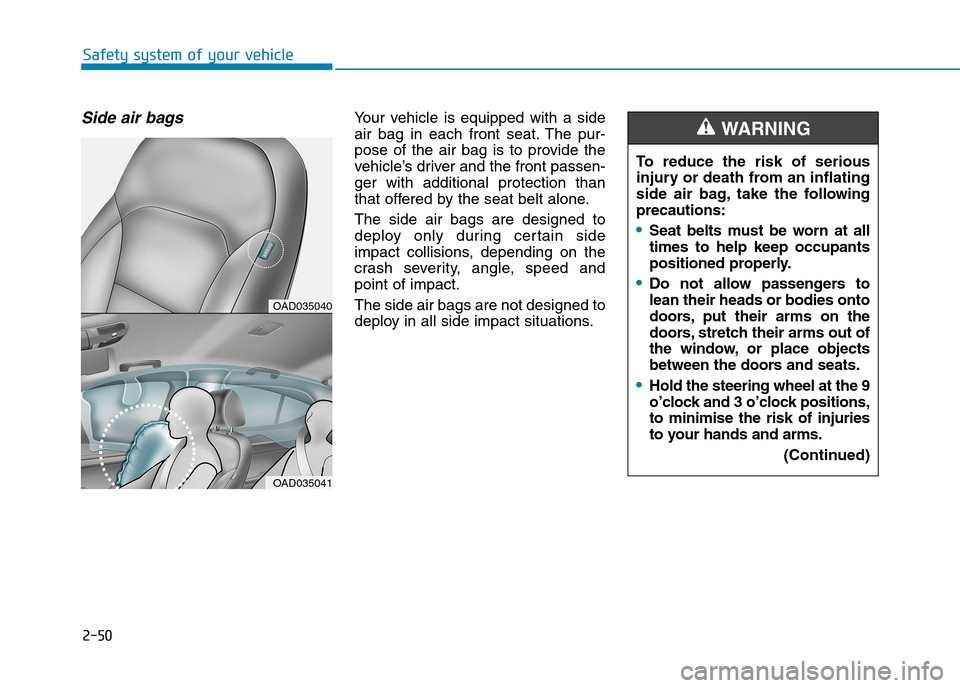
2-50
Safety system of your vehicle
Side air bagsYo u r v e h i c l e i s e q u i p p e d w i t h a s i d e
air bag in each front seat. The pur-
pose of the air bag is to provide the
vehicle’s driver and the front passen-
ger with additional protection than
that offered by the seat belt alone.
The side air bags are designed to
deploy only during certain side
impact collisions, depending on the
crash severity, angle, speed and
point of impact.
The side air bags are not designed to
deploy in all side impact situations.
OAD035040
OAD035041
To r e d u c e t h e r i s k o f s e r i o u s
injury or death from an inflating
side air bag, take the following
precautions:
•Seat belts must be worn at all
times to help keep occupants
positioned properly.
•Do not allow passengers to
lean their heads or bodies onto
doors, put their arms on the
doors, stretch their arms out of
the window, or place objects
between the doors and seats.
•Hold the steering wheel at the 9
o’clock and 3 o’clock positions,
to minimise the risk of injuries
to your hands and arms.
(Continued)
WA R N I N G
Page 95 of 571
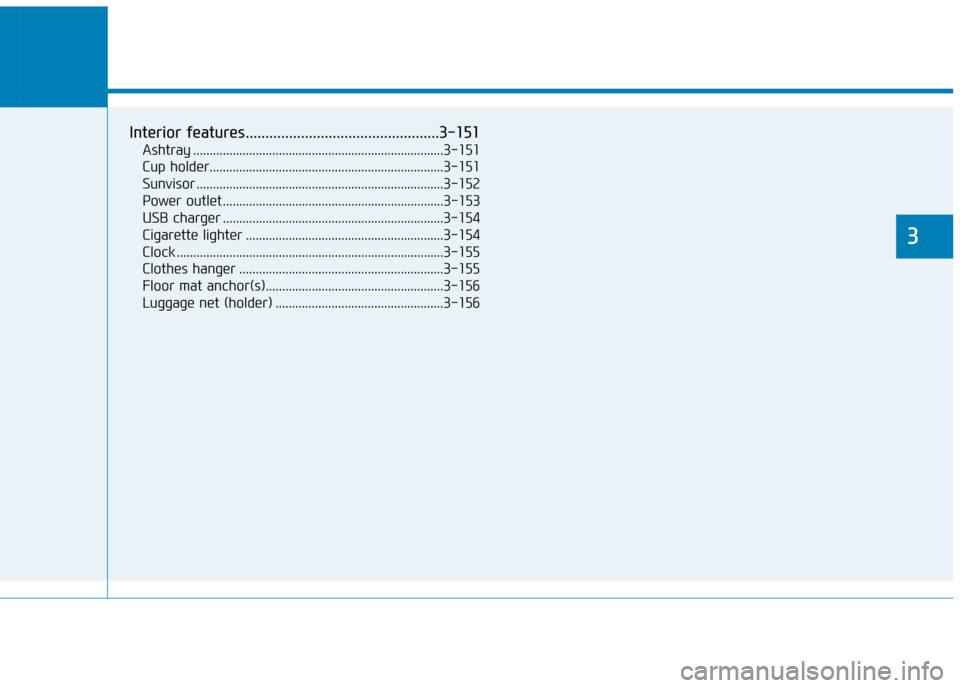
Convenient features of your vehicle
3
Interior features.................................................3-151
Ashtray ............................................................................3-151
Cup holder.......................................................................3-151
Sunvisor ...........................................................................3-152
Power outlet ...................................................................3-153
USB charger ...................................................................3-154
Cigarette lighter ............................................................3-154
Clock .................................................................................3-155
Clothes hanger ..............................................................3-155
Floor mat anchor(s)......................................................3-156
Luggage net (holder) ...................................................3-156
3
Page 139 of 571
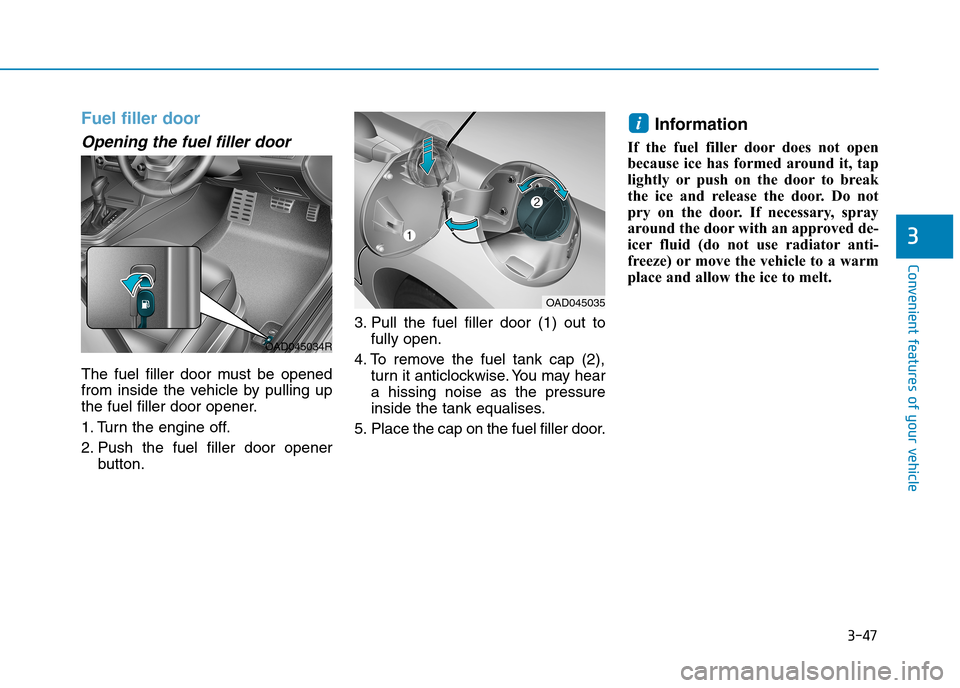
3-47
Convenient features of your vehicle
3
Fuel filler door
Opening the fuel filler door
The fuel filler door must be opened
from inside the vehicle by pulling up
the fuel filler door opener.
1. Turn the engine off.
2. Push the fuel filler door opener
button.
3. Pull the fuel filler door (1) out to
fully open.
4. To remove the fuel tank cap (2),
turn it anticlockwise. You may hear
a hissing noise as the pressure
inside the tank equalises.
5. Place the cap on the fuel filler door.
Information
If the fuel filler door does not open
because ice has formed around it, tap
lightly or push on the door to break
the ice and release the door. Do not
pry on the door. If necessary, spray
around the door with an approved de-
icer fluid (do not use radiator anti-
freeze) or move the vehicle to a warm
place and allow the ice to melt.
i
OAD045035
OAD045034R
Page 140 of 571
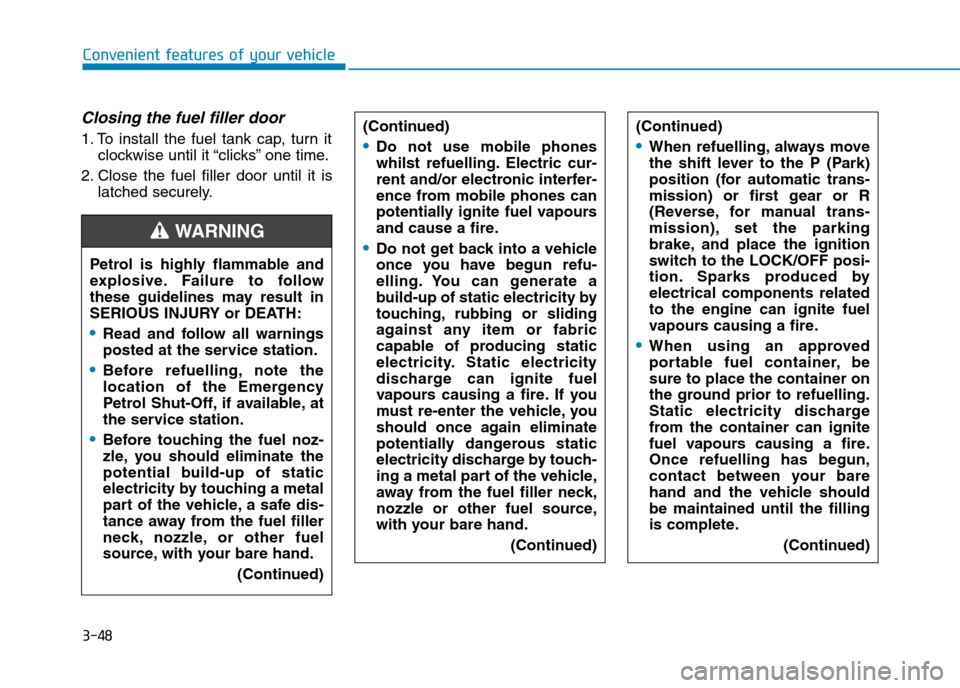
3-48
Convenient features of your vehicle
Closing the fuel filler door
1. To install the fuel tank cap, turn it
clockwise until it “clicks” one time.
2. Close the fuel filler door until it is
latched securely.
Petrol is highly flammable and
explosive. Failure to follow
these guidelines may result in
SERIOUS INJURY or DEATH:
•Read and follow all warnings
posted at the service station.
•Before refuelling, note the
location of the Emergency
Petrol Shut-Off, if available, at
the service station.
•Before touching the fuel noz-
zle, you should eliminate the
potential build-up of static
electricity by touching a metal
part of the vehicle, a safe dis-
tance away from the fuel filler
neck, nozzle, or other fuel
source, with your bare hand.
(Continued)
WA R N I N G
(Continued)
•Do not use mobile phones
whilst refuelling. Electric cur-
rent and/or electronic interfer-
ence from mobile phones can
potentially ignite fuel vapours
and cause a fire.
•Do not get back into a vehicle
once you have begun refu-
elling. You can generate a
build-up of static electricity by
touching, rubbing or sliding
against any item or fabric
capable of producing static
electricity. Static electricity
discharge can ignite fuel
vapours causing a fire. If you
must re-enter the vehicle, you
should once again eliminate
potentially dangerous static
electricity discharge by touch-
ing a metal part of the vehicle,
away from the fuel filler neck,
nozzle or other fuel source,
with your bare hand.
(Continued)
(Continued)
•When refuelling, always move
the shift lever to the P (Park)
position (for automatic trans-
mission) or first gear or R
(Reverse, for manual trans-
mission), set the parking
brake, and place the ignition
switch to the LOCK/OFF posi-
tion. Sparks produced by
electrical components related
to the engine can ignite fuel
vapours causing a fire.
•When using an approved
portable fuel container, be
sure to place the container on
the ground prior to refuelling.
Static electricity discharge
from the container can ignite
fuel vapours causing a fire.
Once refuelling has begun,
contact between your bare
hand and the vehicle should
be maintained until the filling
is complete.
(Continued)
Page 243 of 571
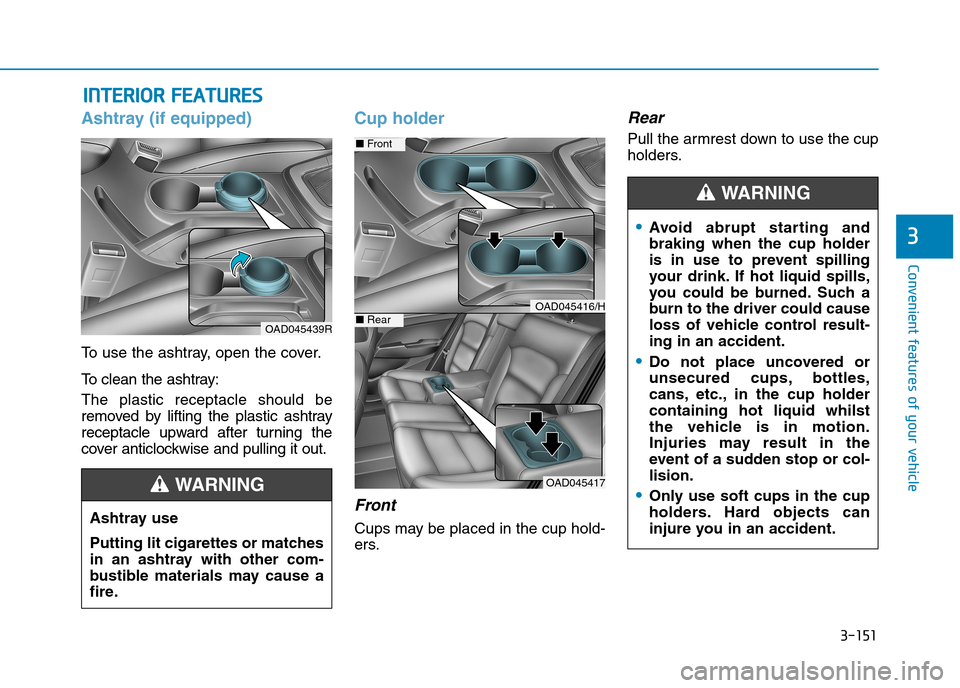
3-151
Convenient features of your vehicle
3
IINNTTEERRIIOORR FFEEAATTUURREESS
Ashtray (if equipped)
To u s e t h e a s h t r a y, o p e n t h e c o v e r .
To c l e a n t h e a s h t r a y :
The plastic receptacle should be
removed by lifting the plastic ashtray
receptacle upward after turning the
cover anticlockwise and pulling it out.
Cup holder
Front
Cups may be placed in the cup hold-
ers.
Rear
Pull the armrest down to use the cup
holders.
OAD045439R
Ashtray use
Putting lit cigarettes or matches
in an ashtray with other com-
bustible materials may cause a
fire.
WA R N I N G OAD045417
■Front
■RearOAD045416/H
•Avoid abrupt star ting and
braking when the cup holder
is in use to prevent spilling
your drink. If hot liquid spills,
you could be burned. Such a
burn to the driver could cause
loss of vehicle control result-
ing in an accident.
•Do not place uncovered or
unsecured cups, bottles,
cans, etc., in the cup holder
containing hot liquid whilst
the vehicle is in motion.
Injuries may result in the
event of a sudden stop or col-
lision.
•Only use soft cups in the cup
holders. Hard objects can
injure you in an accident.
WA R N I N G
Page 247 of 571
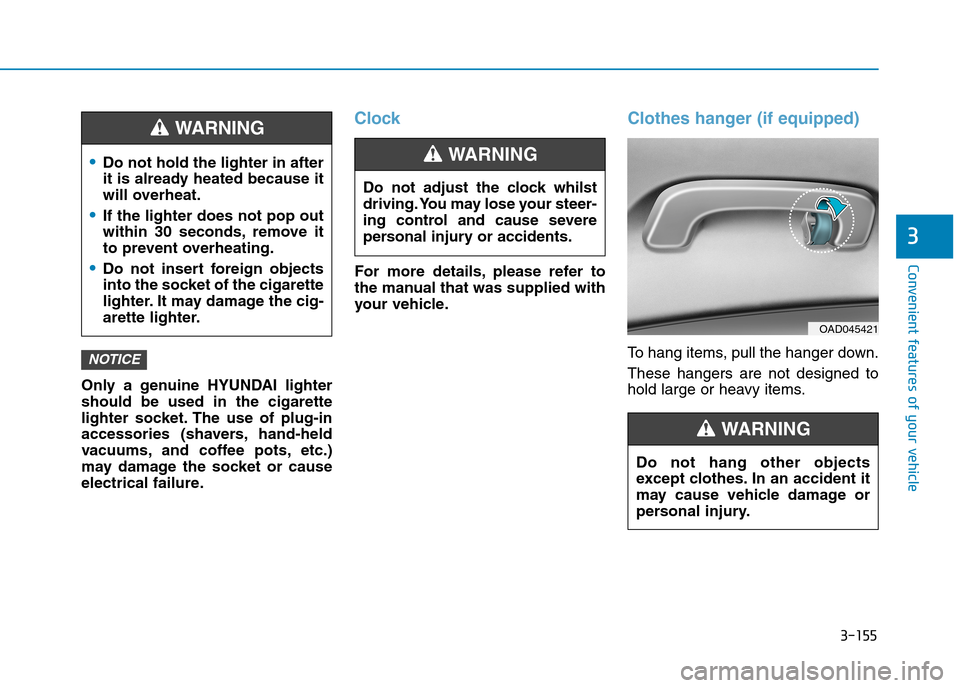
3-155
Convenient features of your vehicle
3
Only a genuine HYUNDAI lighter
should be used in the cigarette
lighter socket. The use of plug-in
accessories (shavers, hand-held
vacuums, and coffee pots, etc.)
may damage the socket or cause
electrical failure.
Clock
For more details, please refer to
the manual that was supplied with
your vehicle.
Clothes hanger (if equipped)
To h a n g i t e m s , p u l l t h e h a n g e r d o w n .
These hangers are not designed to
hold large or heavy items.
NOTICE
OAD045421
Do not adjust the clock whilst
driving. You may lose your steer-
ing control and cause severe
personal injury or accidents.
WA R N I N G
Do not hang other objects
except clothes. In an accident it
may cause vehicle damage or
personal injury.
WA R N I N G
•Do not hold the lighter in after
it is already heated because it
will overheat.
•If the lighter does not pop out
within 30 seconds, remove it
to prevent overheating.
•Do not insert foreign objects
into the socket of the cigarette
lighter. It may damage the cig-
arette lighter.
WA R N I N G